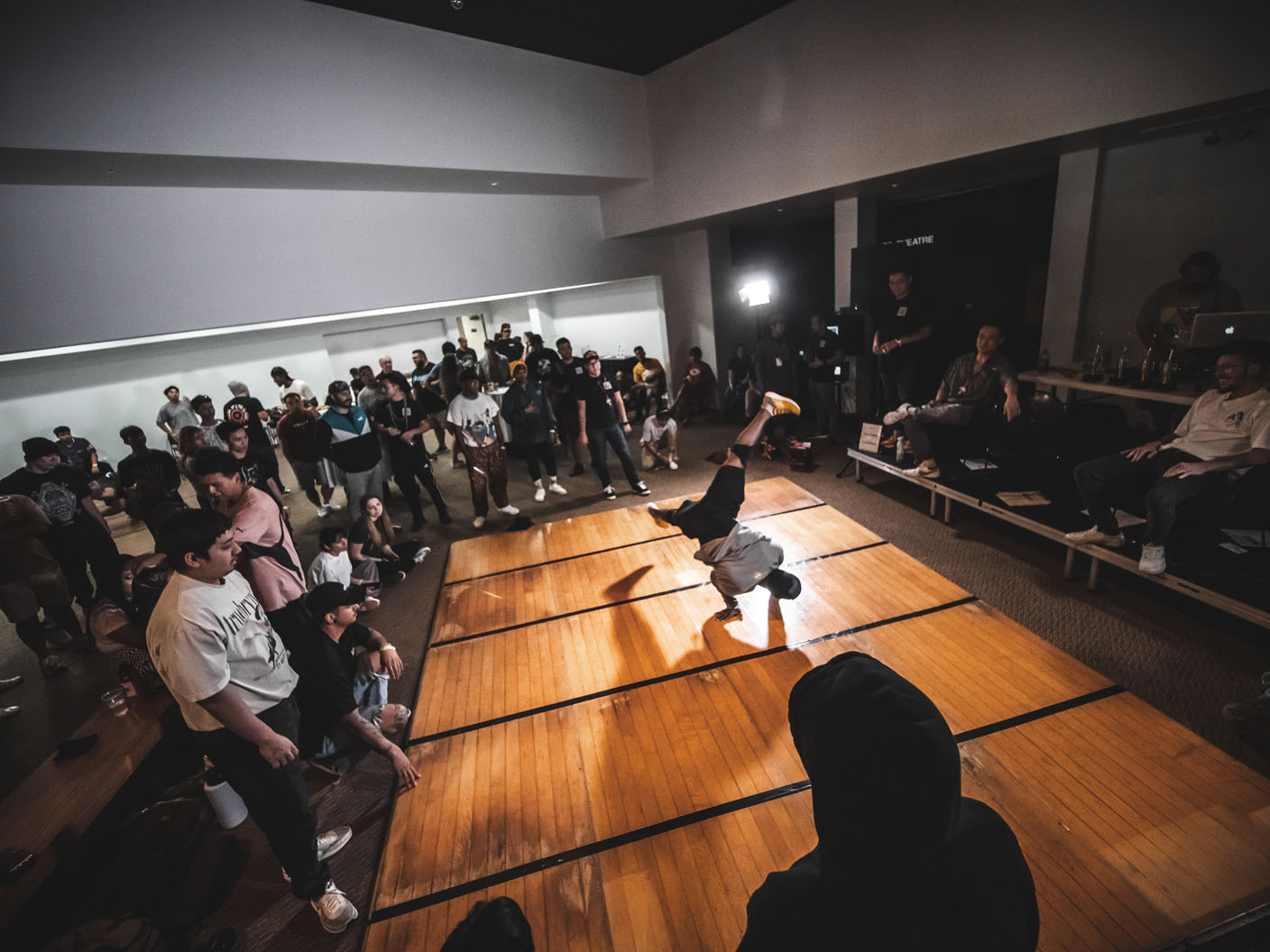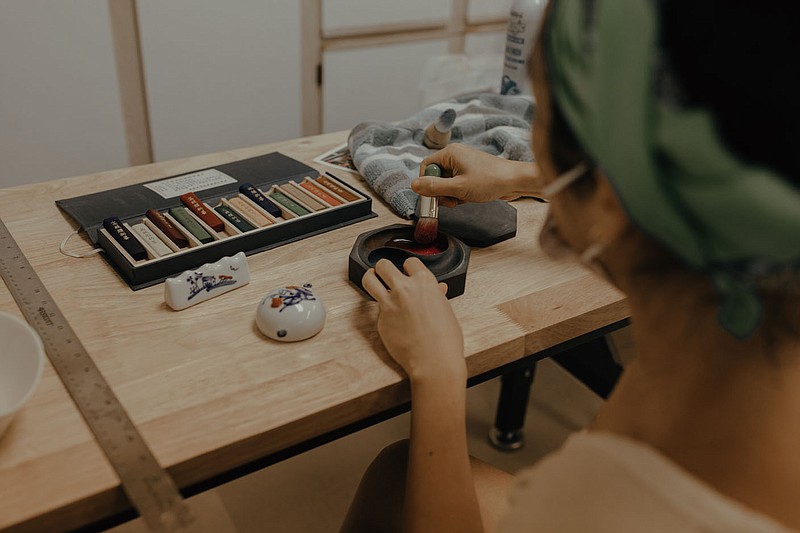Sarah Schellenberg, like many artists, often battles an issue of space. There's not enough of it to hold all the works of art she has in progress.
When she saw a notice online about the creative exchange fund, a program of the Creative Arkansas Community Hub and Exchange (CACHE) that's funded by the Tyson Family Foundation, Schellenberg thought it was perfect and applied.
"I had just been making watercolor paintings on my bedroom floor in the year since I'd graduated school," Schellenberg says from her studio space at The Medium in Springdale. The place is hers for six weeks, and she has plenty of room for her works to stretch out. She's used it to split her time between Fayetteville and here; divvying up her projects over the two locations. "I really wanted to oil paint again and needed space to do it. Space and structure to do something I couldn't exactly do in my tiny apartment.
"I like to work on multiple things at the same time."
CACHE announced June 6 the second year of its Creative Exchange Fund. Applications open Monday, and there are many opportunities for artists of all sorts.
Available are six awards that will go to "Producers," people and/or organizations creating events to engage the community on The Medium campus. The Platform will be awarded to two entities for a large stage production. A total of 16 musicians will be chosen for the Mixtape Music Series, and six awards for group exhibitions of visual artists, artist collectives and facilitators will be available through the Spectra Series, previously known as the Call for Curators.
Last but not least, six artist residencies at The Medium will be up for grabs, much like the one Schellenberg landed. It goes to artists practicing 2-D and 3-D visual arts and supplies a creative studio space for six weeks, granting them a chance to "take creative risks," then engage with the community through a public exhibition or workshop of their choice.
Schellenberg chose to do an informal, open studio event that had a small call for entries. People attending could bring pieces of fabric, ephemera, written material -- whether grocery receipts, napkins "anything flatten-able" -- that she hopes to use in a large-scale collage.
Schellenberg grew up in St. Louis, where she spent a lot of time drawing, learning to sew and using watercolors as her main means of expression. She came to Northwest Arkansas as an English major at the University of Arkansas, but added a second major in art because she saw "people walking around with a big pieces of beautiful paper and what have you," she says. It made her think to herself, "I wish I had a big beautiful piece of paper right now."
Schellenberg loved her art classes in high school and the craft classes she'd picked up in St. Louis, but once she became an art major, she knew instantly that painting should be her concentration.
"I feel like it's been my strong suit, I love how straight-forward it is," she says. "I like that it is grounded in a really long tradition, but that contemporary painting is so established as its own field. It integrates the things I love most about drawing, while still allowing for a lot of flexibility, and I get to create a really solid object with it."
She did observational painting, but during her college studies she became more interested in abstract painting and discovered an obsession with quilts in her sophomore year.
"There's so much similarity between quilting and painting," Schellenberg says. You're "creating this really precise and kind of two-dimensional object. It's like painting but in a way that can be wrapped around you. Kind of an unsung craft for so many women in my family and so many families across middle America."
Take a walk through her studio now, and you'll be greeted with images of nature, such as one work that is a collection of birds, trees and triangles; or remnants of home, such as figures curled into each other, a cat or two and many of quilt patterns.
"This pattern is a popular style," Schellenberg says in reference to the work with birds. Having lots of free rein in this phase, she finally has an excuse to paint the subjects she's always loved: birds and quilts, in this case together. "I love how it combines so many parts and types of fabrics. One piece of fabric can have so many different parts and materials, and they're all compounded by one person."
On the desk nearby is a bird guide. She's been doing her research because her new, budding work places many different bird species together, sometimes adding them in and taking them back out. At this moment it has finches and sparrows, some swooping birds and hawks and some "nonnative species just for fun."
Depicting this collection of birds gives a representation of how a bunch of different things can come together, Schellenberg says, "and for me that's what quilt a often represents." Triangles in the work symbolize the flying geese quilt pattern, and they pervade the entire landscape, weaving through trees to give the sense of movement. "Triangles are so directional and ... it is the boiled down essence of a bird. I enjoy them as a directional force," she says.
Schellenberg's other works in progress include a still life, one has word play, and one features a log cabin quilt pattern that looks a bit singed. Many of her family members are smokers, so it gave her inspiration.
"I love the idea of one of their quilt blocks getting burnt all over, so (this is) a bit of a pun on a burning log cabin, the name of the quilt pattern," she says, noting that she has experimented with placing them in various contexts of time and uses the patterns to create environments, playing around with it.
Brittany Johnson, director of communications for CACHE, says she hopes that a lack of experience won't keep local artists from applying for Creative Exchange Fund grants.
"I would encourage you to apply," Johnson says. "If you have questions of level of experience or professionalism, it's not about that. We're hoping to work with people who need a little support and who need to get their foot in the door."
The program had 150 applicants last year, and Johnson says CACHE hopes to see more applicants from Springdale. It's an important place to the program, which gets its funding locally, and also the home base, one of two studio locations that the organization uses to support artists.
Applicants this time around will have more professional development opportunities tailored to the type of funding that they are applying for, Johnson says, as well as general guidance for things like content creation and getting your artist message out to others.
"We're helping artists with the tools they need to talk about themselves and what they're doing and broadcast it to the world."
 Among the recipients of the Creative Exchange Fund producers award in the past year was Breaking Habits. The result was a hip-hop breakdance jam, basically a break dance competition that took place at The Medium with live DJs. The event brought in breakdancers from across the state, as well as beyond it to Oklahoma and Texas, to compete with rap battles for a cash prize and brought a different crowd to The Medium than what the program typically does, which was exciting, says Brittany Johnson, communications director for CACHE. (Courtesy Photo)
Among the recipients of the Creative Exchange Fund producers award in the past year was Breaking Habits. The result was a hip-hop breakdance jam, basically a break dance competition that took place at The Medium with live DJs. The event brought in breakdancers from across the state, as well as beyond it to Oklahoma and Texas, to compete with rap battles for a cash prize and brought a different crowd to The Medium than what the program typically does, which was exciting, says Brittany Johnson, communications director for CACHE. (Courtesy Photo)
